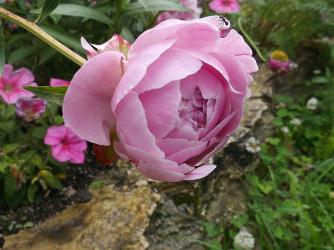Designing Your Perennial Garden
Like old friends that we are happy to see return each spring, perennials add an air of continuity to an outdoor space. We offer an ever changing selection of shapes, sizes and varieties of perennials as well as old favourites at the greenhouse. From full shade to full sun and moist to dry soils, we can help you find the perennial suited for your unique garden.
Preparing your Garden site:
Choose the Site
Choose the site for your perennial garden. Mark the edges with marking chalk or outline with a garden hose. Geometric shapes are more formal, while gently curving garden beds lend an air of relaxation and informality. If your garden will be surrounded by lawn, it is a good idea to make sure the curves of the garden bed are gentle enough to accommodate the turning radius of your lawnmower. This lessens the need for hand trimming of grass. Try to make the garden at least four feet from front to back to provide space for successive perennials to bloom.
Prepare the Soil
Remove the sod from the area with a shovel and add it to your
compost pile. Dig the remaining soil deeply and mix in topsoil and amendments like well rotted
compost, manure or peat moss. When you are finished, the soil should be light and fluffy, able to drain well and with a chocolate brown colour. Good soil preparation is essential when starting a
perennial garden and particularly of importance in our area because of the soils high in clay content with a relatively high PH. The quality of soil will dictate the success you have
with your perennials. There are plants however that cope with our poor soils better than other plants. If you wish to add landscaping edging to
help prevent weeds from creeping in, now is the time to install it. Edging is a good idea as it really helps keep your lawn from creeping into your carefully planned garden!
Add in Hardscape Features
Adding in hardscape features like stone or brick walkways are great way to make your garden have a permanent feel as well as adding interest to your space. Large rocks are often great additions, but choose carefully as they can end up just looking out of place. Choose rocks with an interesting colour and/or shape. They should also be an appropriate size that blends with the plants, higher than the finished height of the plants without overwhelming the plants. When adding a feature like a rock, bury at least one third of its height in the ground for a more natural look. Once you have your garden dug, edged and features added it is ready to plant. Now its time to head to the greenhouse. If you can't quite decide on which plants, we can help you find suitable plants that bloom in succession and suit your tastes, budget and the climate, no problem!
Choose Your Plants.
Once the ground work has been done preparing the garden, it can finally be planted! Bring your ideas, garden plans or photos in and we will help you choose the right plants for you. We have a good selection of quality perennials, trees and shrubsthat enhance your yard!


Not sure where to start? Try starting by picking a perennial that really catches your eye. This can be the feature plant and can be repeated in groups to tie the whole garden together. Or start with a colour palette or leaf shape that appeals . Cool, calm harmonizing colours or wildly bright contrasting colours.
Choose perennials by their heights, shapes, sunshine needs, and bloom time. For gardeners living in windy areas (along Lake Manitoba, for instance) pay careful attention to wind tolerance. Also plants tolerant to wet soils. We'd be happy to help you select plants that meet this criteria.
To have flowers all summer long, mix plants that have different bloom periods, check the tags or ask us for the plant's usual bloom time.
In general, position taller plants towards the back of the border, shorter ones at the front. If the bed is viewed from all sides place the taller plants towards the middle or in undulating drifts.
- Choose plants that are hardy in your climatic zone. Climatic zones are way of quantifying whether a plant is likely to survive in an area. Climatic zones factor in lowest winter temperatures, last expected spring frosts and frost free days in the summer. In the southern Interlake we are in zone 3b. The northern Interlake (somewhere north of Ashern) and Thompson area are zone 2. This is a rule of thumb, and you know the microclimate of your garden space best. Is there a sheltered space along a foundation where you can sneak in a plant not recommended for our zone? Or an area that receives a great deal of protective snow cover or is sheltered from cold spring winds? Or if you are prepared to cover the perennials in the fall, it adds to winter hardiness.

Groupings of plants in odd numbers have more visual impact and a more natural look.

Tucking in a few annuals and spring bloomingbulbs will help ensure colourful blooms from early spring throughout the summer,filling in any gaps in bloom times.
- Be sure to leave adequate space around the plant (consult the tag) to let it grow to it's fullest size.
- A perennial is considered
to be a plant that lives for at least three years but many are very
long lived like the peony. These venerable garden favourites may last
one hundred years but prefer not to be moved.